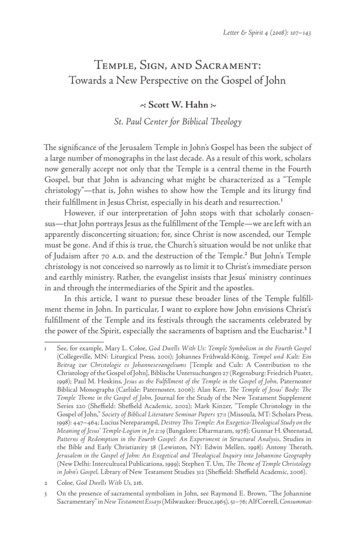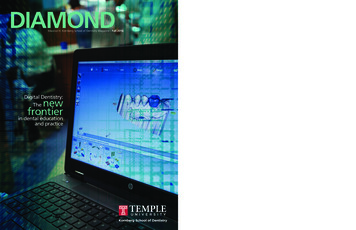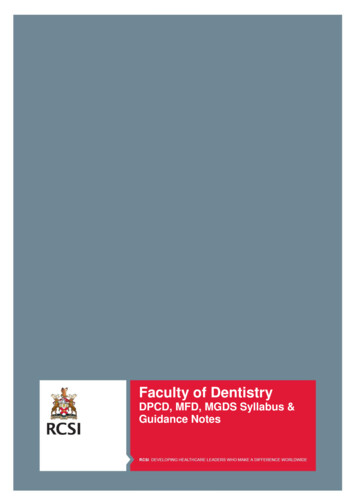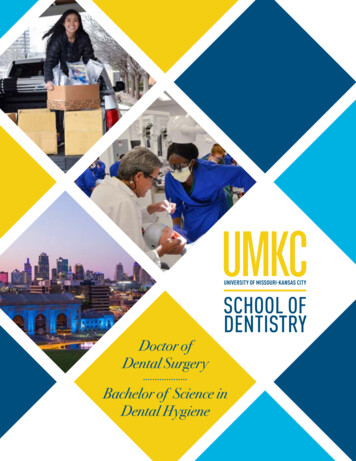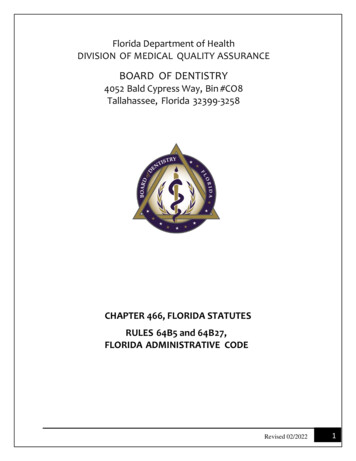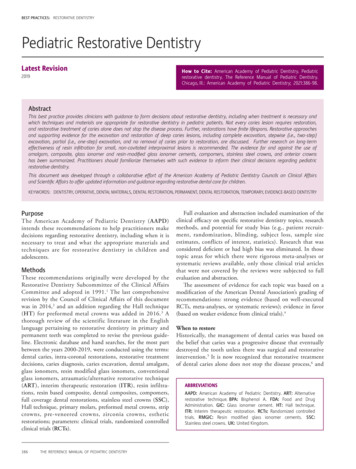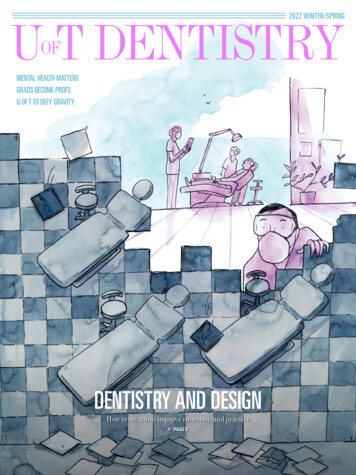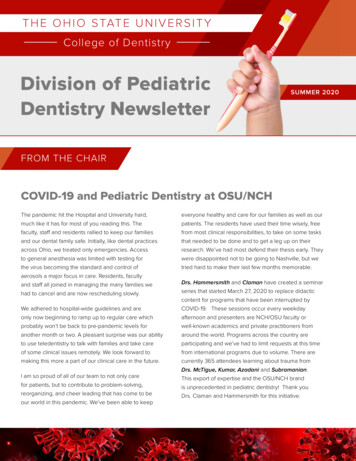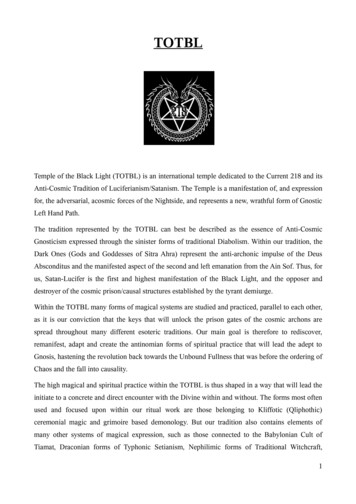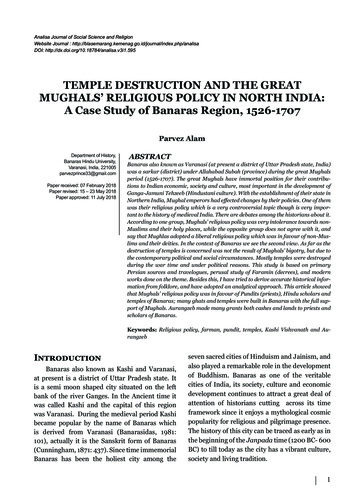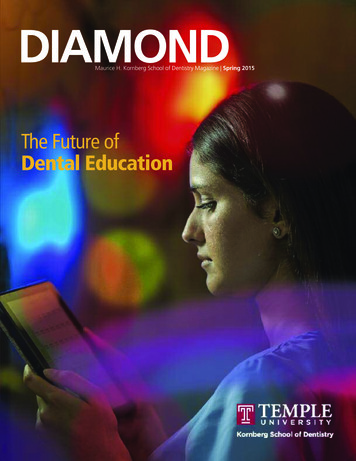
Transcription
DIAMONDMaurice H. Kornberg School of Dentistry Magazine Spring 2015The Future ofDental Education
DIAMONDMaurice H. Kornberg School of Dentistry Magazine Spring 2015Contents1 Dental Education at the Crossroads: Can We Meetthe Challenge?Amid I. Ismail, BDS, MPH, MBA, DrPH, Dean4 The Future of Dental EducationThe Future of the Dental Profession:A Primer for New GraduatesKathleen O’Loughlin, DMD, MPH6 Dental Education at the Crossroads:Reflections After 20 YearsRichard W. Valachovic, DMD, MPH8 An Economist’s Take on the Dental Care MarketMarko Vujicic, PhD22 Student SpotlightKhaled Alnajdi, Class of 2018Nicholas Bizzaro, Class of 2017Amrita Bhan, Class of 2016Janine Musheno, Class of 201526 Making Dental School Accessible: Temple Dental toDistribute 700,000 in Scholarships This Year28 Mission TripDelivered Healthy Smiles in Jamaica32 Dental Students Provide Oral Healthcare to PeruvianOrphans34 EducationThe Evolution of Comprehensive Care10 How Did I Succeed in Private PracticeWilliam Choi, DMD36 Kornberg Begins Integrated Approach toBasic Science Curriculum12 Expectations of Employers from Dental EducationReem S. Shafi, DMD38 What Does the Next Generation of ExaminationsLook Like for Dental Students?16 FacultyFocus on FacultyJo Ann Allen Nyquist, BSDH, MA, EDSBetsy Tweddale, DMDChrystalla Orthodoxou, DDSTaheerah Sabb40 Community OutreachServing Those in Need20 Reflections on My Experience at Temple DentalDr. Sally Gray42 Alumni1964 Alumnus “Goes for the Gold” During the2008 Olympics in Beijing44 1964 Reunion Attendees45 Gallery of Success AwardsJay Michael Goldberg, DDS46 Class Notes47 In Memoriam48 Dr. David Bresler, ’79Page 1249 Continuing Education CoursesPage 36Page 22Page 44
MESSAGE FROM DEAN AMID I. ISMAILDental Education at the Crossroads:Can We Meet the Challenge?Since 2009, the hard work of our faculty, students and staff, andthe tremendous support of our alumni, have enabled us to meetand surpass contemporary best practices in dental education. Ourclinics continue to provide students with a strong clinical education,and more patients visit the school to receive care than ever before.Clinical income, in spite of the cuts to adult Medicaid in Pennsylvania,has almost doubled since 2010. These funds are reinvested in newprograms and in hiring additional faculty and staff, as well as inoffsetting the need for higher tuition increases. We have begun toachieve our shared vision for Temple University Kornberg School ofDentistry to be branded as an internationally recognized center forexcellence in dental education; however, the pace of change in ourfield is relentless, requiring us to constantly respond to continuousenvironmental challenges that are shaping the future of dentaleducation. A wise leader today should set the stage for a new“norm” of change (Dr. Kathleen O’Loughlin, page 4). This is thetheme of this issue of our Diamond. It is hard to predict the future,and those who try are usually scorned if their projections are notrealized. Our guest authors in this issue cite convincing evidence andanalysis of major trends that I believe make the job of“setting the stage” for the future of dental educationconsiderably more likely to succeed.If there is one word that describes the future of dentistry,it will be “smart.” Smart materials, smart tools (thatcollect data and make decisions) and smart decision algorithms will enable dentists to treat more patients andprovide better care at a lower cost. We will experience anexponential growth in digital dentistry that will transform the way dentists practice and the skill sets theyrequire. Our clinical curriculum must keep up with thesechanges, requiring dental school faculty to gain andpractice new sets of skills themselves so they can teachthe rising generations of dental students.Dean Amid I. IsmailLaura H. Carnell Professor“If there is one word thatdescribes the future of dentistry, it will be ‘smart.’ Smartmaterials, smart tools andsmart decision algorithmswill enable dentists to treatmore patients and providebetter care at a lower cost.”— Dean Amid I. IsmailThe issue of the future supply of dentists that Dr. Marko Vujicic, chiefeconomist of the American Dental Association, discusses (page 8)points to the incongruity of the current trends of educating moreDiamond Spring 20151
dentists in an environment of changing practice patterns, stagnant demandfor dental care, expansion in care for low-income children and special populations, and the debt burden faced by dental students upon graduation.These forces may lead to a significant decline in applicants to dental schoolswith effects that will reverberate throughout the profession and the dentalhealthcare system.I contend that we will need fewer, not more, dentists to work in this environment. Dental schools are increasingly dependent on high tuition andthat is not the right course. We must respond to the challenges by buildingfinancially sustainable and revenue-generating patient care centers; usingdigital methods of learning; reducing student debt and building modelsthat will allow our graduates toown practices; and successfullydealing with the shifting trends inthe patient population.“The rapid pace of change is dizzying, andour dental school is in a race to make theright changes and steer in the right directionto ensure the oral health and quality of lifefor the members of our communities.”In the dental market, the key competitive advantage of the futurewill be the size and diversity of thepractice. The market is already correcting itself by encouraging largeinvestment in consolidated andgroup-managed practices that offerguaranteed salaries and benefits(Dr. Reem Shafi, Class of 1998, page 12). Group practices, like any new trendin dentistry, have been negatively received, but I believe they will emerge inthe near future, after several adjustments, as a force that will shape bothdental practice and dental education. Large group practices definitely candeliver better-integrated, lower-cost and value-focused healthcare, andcompete on outcomes. They can also deliver on integrated medical-dentalbehavioral care better than any single solo or small group of practitionerscan.I am for balance in all systems of healthcare. Based on historical experientialinformation on how successful systems work, I contend that we muststrengthen and prepare solo or small independent group dental practices tomaintain their competitive edge in the 21st century. Hence, it is the vision ofTemple University Kornberg School of Dentistry to educate general dentistswith advanced clinical skills who can learn and adapt fast to changes in2Diamond Spring 2015— Dean Amid I. Ismail
their environment. Our task is to prepare dentists who are “lean managers” oftheir practices and who can provide high-quality care at lower cost. This formula,coupled with a focus on customer service, will enable the new generation of sologeneral practitioners to compete with large group practices. In 2015, we will starta course on how to manage practices in underserved communities where themajority of patients are covered by Medicaid or are low-income earners. We willalso start this year, with a generous in-kind contribution from Henry Schein, Inc.,expansion of our digital dentistry program to cover all aspects of clinical care.Digital dentistry could have a significant impact on reducing the cost and timerequired to provide dental care.We are in the beginning stages of changing our curriculum to be focused morethan before on integrated and comprehensive care (Dr. Richard Valachovic, page6, and Dr. Daniel Boston, page 34). Our system of providing care is becomingmore patient-centered. We will introduce more-advanced financial literacycourses and practicums. Soon we will open a sedation center and a medical clinicat the dental school to treat patients that we currently must refer out to otherfacilities. We have approval to start renovating a suite to open the GreaterPhiladelphia Health Action Primary Care Clinic at 3223 N. Broad Street. Two nursepractitioners (NPs) and staff will consult and provide healthcare for all patientswho desire to receive care at our medical clinic. Moreover, the NPs will work withour dental faculty to screen patients and manage medical conditions, consultwith all clinics, and provide prescriptions at low cost to our patients.The rapid pace of change is dizzying, and ourdental school is in a race to make the rightchanges and steer in the right direction toensure the oral health and quality of life forthe members of our communities. I invite allreaders of this magazine to join us in thisrapid and invigorating period in the life ofTemple Dental. With your help we can meetthe challenges of the future. Please visit yourdental school and be PROUD.“I invite all readers of this magazineto join us in this rapid and invigoratingperiod in the life of Temple Dental.With your help we can meet thechallenges of the future.”— Dean Amid I. IsmailDiamond Spring 20153
THE FUTURE OF DENTAL EDUCATIONThe Future of the Dental Profession:A Primer for New GraduatesWe live in a rapidly changing world. Change isthe new normal. We see it in our daily lives,from the way we communicate to how we commute. Emerging smart technologies, combined withnew economic realities and a rising consumerism,are forcing public-focused organizations large andsmall to compete and adapt like never before.The dental profession is not immune to these sweeping changes. But by analyzing the data driving thetransformations within dentistry, perhaps we cananticipate what's in store in the future.According to research compiled by the AmericanDental Association's Health Policy Institute(ADA/HPI), the profession is seeing: Increasing diversity—this is especially true whenit comes to gender; females now make up nearlyone-half of dental school enrollment.By Kathleen O’Loughlin, DMD, MPHExecutive Director/Chief Operating OfficerAmerican Dental Association The rise of group practices—rapidly increasingnumbers of new dentists are moving toward thismodel, which meets their needs whether they arefinancial, work-life balance, job satisfaction or afeeling of inadequacy around business managementin a complex and challenging healthcare environment. Millennials make up more than 30 percent ofgroup practice dentists, and only about 5 percent ofsolo practice dentists. Exploding dental student debt—since 2001, ithas more than doubled, to more than 240,000 perdental student on average, driven by a doubling indental school tuition and fees. A dental disparity in which children have seenremarkable gains in dental coverage and access inrecent years while the same cannot be said for mostunderserved adults.4Diamond Spring 2015
A lack of growth in overall consumer demandfor dental services, in dental spending and in dentistearnings during the last decade.These are the trends heading into the future. Someof them, like the growing diversity within our profession, should be embraced and nurtured. Others,like the rising student debt and dental health challenges facing the underserved, must be addressed.Still others—like the increase in group practices—aremerely the new economic realities of our industrythat all dental professionals must face.What's clear as we move forward is the need for astrong and vibrant ADA to help empower dentalprofessionals in these challenging times—fromstudents and new dentists to those about to retire.During the past couple of years, ADA has beenadapting to meet the needs of the future and stayrelevant in these transformative times. We’ve beenmodernizing our technology to help membersbetter connect with our association. Today’s newdentists demand the same outstanding and measurable value and convenience from the ADA that theyexpect from Apple, Starbucks and the other companies they rely on. By updating ADA technology, weare better able to provide members with quality andcutting-edge products and services to empowerthem in today’s world.ADA has been preparing for the future through theAction for Dental Health, our community-basedmovement on behalf of the underserved. Thousandsof member dentists are making a difference bybringing dental health and education to those inneed. Helping communities find dental homes,keeping dental patients from having to go to hospital emergency departments, making sure the elderlyare able to get the care they need and want, andimproving our public health and Medicaid programsare priorities.ADA is enhancing its engagement with dental students, faculty and new dentists to talk about theways we can help members prepare for the futureon an individual level, including lifelong learningthrough best-in-class continuing education, trainingin evidence-based dentistry and business management education/leadership development throughour Center for Professional Success.But ADA is more than just a resource to rely on—we’re a family of 158,000 members who are a hugesupport network for the mutual challenges we allface. I encourage you to seek out a mentor, a localADA leader and become active. By reaching out,you’ll meet colleagues who care about your success,and you will find friends who will be valuable assetsthroughout your lives—I know I did, and my mentors changed my life.The future is yours for the taking—through the ADAyou can arm yourself with the skills, knowledge andsupport to prepare for the future and be a successthroughout your career. You are our number onepriority!“The future is yours for thetaking—through the ADA youcan arm yourself with the skills,knowledge and support toprepare for the future and be asuccess throughout your career.”— Dr. Kathleen O’LoughlinDiamond Spring 20155
THE FUTURE OF DENTAL EDUCATIONDental Education at the Crossroads:Reflections After 20 YearsThe Institute of Medicine (IOM) published a reportof a study in 1995 entitled “Dental Education atthe Crossroads: Challenges and Change.” It wasdesigned to be an independent assessment of dentaleducation. The timing was right for such a study. Sixprivate dental schools had closed in the previousdecade and enrollment reductions had significantlyreduced the number of graduates. Several otherschools were at risk for closure. There was concernabout the relationships between dental schools andtheir parent institutions, and between dentistry andhealthcare in general. The political environmentwithin dentistry was challenging at best. The IOMfound that “the dental profession is at odds with itselfon a number of issues including work force policies,licensure, and health care restructuring.” We weredefinitely at a crossroads.By Richard W. Valachovic, DMD, MPHPresident and CEOAmerican Dental Education AssociationThe IOM Committee on the Future of Dental Education consisted of 18 senior leaders in higher educationand healthcare. They undertook a comprehensiveapproach that engaged the key communities of interest. They identified five key elements for the future:1. Dentistry will be more closely aligned with medicineand the healthcare system;2. Clinical dental education needs to more patientcentered and community-based;“Here we are 20 years later. .A number of events have occurredin the ensuing two decades thathave created a new environmentfor dental education.”— Dr. Richard W. Valachovic6Diamond Spring 20153. Dental schools need to demonstrate their value totheir parent institutions;4. Reforms in accreditation and licensure are neededto enhance the quality of dental education; and5. Testing of alternative models of education,practice and performance assessment are required,especially related to workforce issues.
“There is a phenomenalopportunity for us to grow as ascientifically based profession,conducting innovative researchand scholarship, producingpractitioners who are criticalthinkers and lifelong learners,and providing accessible andaffordable dental care to ourcommunities.”— Dr. Richard W. ValachovicIn the end, they developed 22 recommendations toprovide guidance for the 10- to 20-year horizon theyenvisioned.Here we are 20 years later. With the value of 20/20hindsight, we can see that the report was prettyaccurate about the challenges that we faced at thattime. The study was undertaken toward the end ofa period of contraction of dental education, a timeof fear about the future, and an era of political turmoil within the profession. But a number of eventshave occurred in the ensuing two decades that havecreated a new environment for dental education.Although one more dental school closed subsequentto the report, 12 universities have opened new dental schools and there are many more under consideration. The relationships between dental schools andtheir parent institutions have improved dramatically,fulfilling a vision that the dental school be seen asthe “front porch” of the university through theircommunity-oriented approaches to education andpatient care. The healthcare system has changed inmany ways, but dentistry has not yet found its placein these new collaborative care models. Interprofessional education (IPE) is becoming more integratedinto academic health centers and dentistry is a willing partner in this transformation. Substantialchanges have been made in dental accreditation,and progress is being made in licensure reform.Many states are developing new and expandedmodels of practice and this remains a controversialissue.To me, the IOM report is as alive and enduringtoday as it was 20 years ago. It continues to be aroadmap for our future. We have made greatprogress, but there is still much to be done. The reality is that change takes time. We faced a crossroads in 1995, made some choices, and now findourselves at another crossroads in a changinghealthcare and academic world. There is phenomenal opportunity for us to grow as a scientificallybased profession, conducting innovative researchand scholarship, producing practitioners who arecritical thinkers and lifelong learners, and providingaccessible and affordable dental care to our communities.The IOM report is available for download ecrossroads-challenges-and-change.Diamond Spring 20157
THE FUTURE OF DENTAL EDUCATIONAn Economist’s Take on the Dental Care MarketTBy Marko Vujicic, PhDChief Economist and Vice PresidentHealth Policy InstituteAmerican Dental Associationhe past decade has seen significant shifts in themarket for dental care in the United States. TheAmerican Dental Association’s Health Policy Institutehas done a substantial amount of in-depth researchon dental care utilization, dental spending, barriersto dental care, dentist income and busyness levels,Medicaid and other important aspects of the dentalsector. One of our most important findings is thatdental care utilization among adults has been declining steadily since the early 2000s, a trend that isunrelated to the Great Recession. In contrast, moreand more children are receiving dental care, especially low- and lower-middle-income children. Theseshifts in dental care use patterns have had an enormous impact on total dental care spending in theUnited States, dentist earnings, and dentist busynesslevels. In a nutshell, the dental economy started tostagnate before the economic crash and is showinglittle sign of recovery through 2013, the most recentyear for which data are available. Declining demand,in the face of a fairly stable supply of dentists, unsurprisingly has led to stagnant average dentists earning in the United States for the past several years.This should come as no surprise to both economistsand non-economists.Looking to the future, what will happen to demandfor and supply of dental care? On the demand side,there are a lot of factors that potentially will comeinto play. Research we just completed shows that thetop two reasons adults say theydo not intend to visit a dentist inthe next 12 months are cost andno perceived need. Among highincome adults, no perceived needis by far the most important reason. Children, on the other hand,face far fewer barriers to dental“One of our most important findingsis that dental care utilization amongadults has been declining steadilysince the early 2000s, a trend that isunrelated to the Great Recession.”— Dr. Marko Vujicic8Diamond Spring 2015
care. In fact, the share of U.S. children without any form of dentalcoverage is at its lowest level ever.Dental care utilization among U.S.children is at its highest level ever.Other than Medicaid expansion,which could extend dental benefitsand spur demand for dental careamong low-income adults in manystates, there is nothing on the horizon,in my view, to reverse the downward trend in dentalcare use among adults. The Medicaid expansion issignificant—up to 8.3 million adults gaining dentalcoverage. If that increased coverage translates to increased dental care use, the Medicaid market willsee a boom. We modeled the effect of the agingbaby-boomer population on demand for dental careand total dental spending. We found that the expected increase in dental spending in the comingyears among children and seniors will not counteract the decline among adults. Indeed, a new normalof zero growth may be upon us.“Increased interprofessional collaborationhas the potential to increase referrals andallow dentists to contribute much moresignificantly to whole-body health.”On the supply side, we just completed a sophisticated empirical model of the future supply of dentists. Contrary to much of the conventional wisdom,the supply of dentists is likely to increase steadily inthe coming years. Combined with sluggish demandfor dental care, increased numbers of dentists in themarket could very well lead to continued stagnationin average dentist earnings. Practice consolidation isexpected to continue as well.— Dr. Marko VujicicThere are also tremendous opportunities openingfor the dental profession in this period of majortransition in the U.S. health care system. Increasedinterprofessional collaboration has the potential toincrease referrals and allow dentists to contributemuch more significantly to whole-body health. Anew wave of healthcare consumerism and a drivefor value and quality will bring increased marketshare to dental practices that demonstrate highvalue for dollars spent on care. The profession is onthe cusp of significant change and with this changecome exciting new opportunities. Dentistry is an extremely attractive profession in terms of return oninvestment when compared to other professionaloccupations and is likely to stay that way for yearsto come.For more information on the Health Policy Instituteand to access research cited in this article, visitwww.ada.org/hpi.Diamond Spring 20159
THE FUTURE OF DENTAL EDUCATIONHow Did I Succeed in Private PracticeIhave been in private practice for only four years,and I feel very fortunate to have the opportunityto constantly seek out new graduates to add to ourgrowing team of dentists. I take particular interestin advising students and residents from variousdental schools who are about to join the workforceregarding what employers are looking for whenconsidering a new graduate for an associate dentistposition. These attributes are a few of the mostimportant qualities I seek:1. Punctuality. There may be a variety of excuseswhy someone is late; however, it does not changeanything. Excuses only waste more valuable teamtime which could be spent for productive work.2. Diligence. During working hours, there shouldbe no downtime. Employees who are able to keepthemselves busy finding and performing neededtasks are invaluable to a dental practice.William Choi, DMD3. Compassion. We must remember that some ofour patients may come from a very difficult background and could use someone who understandswhere they are coming from and who caters to theirneeds.Class of 20094. Intellectual Curiosity. The real school juststarted. You barely got a license to inject, drill andpull. Now is the time to find out what you are madeof. Dentistry requires lifelong training to fine-tuneyour communication and clinical skills.5. Team Player. We've all heard this saying numerous times, but when it applies to private practicedentistry, the importance of collegiality is profound.The individual role of a single doctor is no moreimportant than the role of any other staff member,regardless of whether that staff member is yourmanaging dentist or your back-office assistant.10Diamond Spring 2015
Providers who truly understand this concept willhave easier, more pleasant workdays while thosewho forget this idea will have a tougher time on thejob market.One of the most valuable pieces of advice I give tonew graduates is simply: “Work where you loveliving.” Your happiness and the time you have atthis stage in life is incredibly valuable. Don’t spendhours of your free time driving or desperately seeking things to do.Lastly, find motivation within our profession. If youever find yourself feeling that private practice is anobligation to meet your financial needs but wishyou could do something else with dentistry, try dedicating some time outside of private practice towardan unmet need. I have devoted the past four yearsvolunteering one day per week to teach oral surgeryor hospital dentistry. Instead of being exhausted orburdened by my private practice career, I find volunteering the perfect escape where I can invest myskills to advance a profession I love.Diamond Spring 201511
THE FUTURE OF DENTAL EDUCATIONExpectations of Employers from Dental EducationDentists are healthcare professionals, and theirpatients expect them to be experts in oralhealth. Dental employers, on the other hand, notonly expect their associates to be good clinicians, butthey also demand that they possess sound interpersonal skills and have good business acumen.On the clinical side, I see more and more dentalstudents graduating from dental schools with limitedknowledge of endodontic and, specifically, of rotaryendodontic, a standard in most practices. Dentalemployers expect graduating dentists not only to beproficient in using these systems, but also to becomfortable in treating molar root canals. It wassurprising for me to learn that, while in school, astudent had attempted only one multirooted rootcanal. Endodontic is the basic bread and butter ofdentistry, and it is very important to be skilled inendodontic. Unfortunately, this lack of trainingmakes them reluctant to treat emergency patients,particularly those who need a molar root canal.By Reem S. Shafi, DMDCEOTwo Rivers Dental, P.C.Class of 1998Another clinical factor is speed and confidence. It is key to being a successful dentist, and yet I see most dental students graduating with alack of such skills. Private practice is very different from a dental schoolsetting. In the real world, patients do not like to spend time in thechair; they want the treatment done and then out of the chair andback to their work. Dental schools can help students by sending themon a two-week internship in a private practice to learn how the realworld works.“It is clear that dental employersexpect young dentists to beexcellent clinicians, but to succeedin the post-school world, dentistsneed to be good entrepreneurs andsound businessmen as well.”— Dr. Reem S. Shafi12Diamond Spring 2015The other important clinical consideration isimplant dentistry. Today, patients are veryinformed about their dental health and theoptions available. For example, restoring missingteeth with crown and bridge is no longer thebest treatment option. People are aware ofimplants. To this end, dental students must haveconsiderable exposure to implant restoration.While in school, they should be taught treatment planning for implants instead of bridges.
It is clear that dental employersexpect young dentists to be excellent clinicians, but to succeed inthe post-school world, dentistsneed to be good entrepreneursand sound businessmen as well.To this end, dental employersexpect that along with clinicaleducation, dental schools mustinclude additional businesseducation in their curriculum.On the business side, among thespecific skills the employers expect graduating dentists to knoware marketing, insurance, financing, accounting and, most important of all, management. In otherwords, they should know theelements of a successful dentalpractice and know the best wayto monitor the performance oftheir practice. As clinicians, theymust provide the best care totheir patients, and as businessmen, they need to keep one eyetoward maximizing revenues andthe other toward minimizingexpenses.As a dental employer who interviews many dentists every year,my hardest interviews are withthose dentists who have justgraduated from dental schools.That is mainly because mostgraduating dentists lack even thebasics when it comes to possessing business skills surrounding theprofession of dentistry. For example, they lack the skills to read aDiamond Spring 201513
simple profit-and-loss statement,or to understand how the insurance industry works or how tomanage accounts receivable.Financial success in dentistry requires a multitude of skills. Morethan half of the graduating dentists will one day open their ownpractices. In that role, they will berequired to become good CFOsof their practices and will beexpected to know the ins andouts of dental business.For example, in the beginning,most graduating dentists will joinother practices as independentcontractors. As an independentcontractor, their compensation isgenerally based on a percentageof collections. And a major sourceof collections is insurance payments. Yet, most graduatingdentists know little about howthe dental insurance works. At aminimum, I expect young dentists14Diamond Spring 2015to know the difference betweenindemnity and PPO plans; between discount and HMO plans.They should know patients’ copays and deductibles. I expect thedental education they receivefrom dental schools to ma
Maurice H. Kornberg School of Dentistry Magazine Spring 2015 Contents 1 Dental Education at the Crossroads: Can We Meet the Challenge? Amid I. Ismail, BDS, MPH, MBA, DrPH, Dean 4 The Future of Dental Education The Future of the Dental Profession: A Primer for New Graduates Kathleen O'Loughlin, DMD, MPH 6 Dental Education at the Crossroads:
